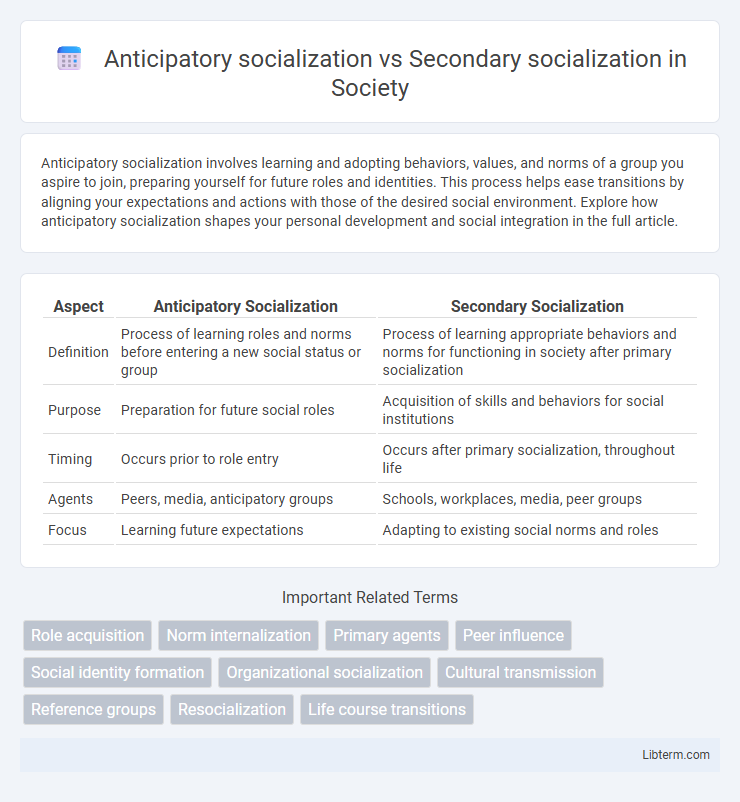Anticipatory socialization involves learning and adopting behaviors, values, and norms of a group you aspire to join, preparing yourself for future roles and identities. This process helps ease transitions by aligning your expectations and actions with those of the desired social environment. Explore how anticipatory socialization shapes your personal development and social integration in the full article.
Table of Comparison
| Aspect | Anticipatory Socialization | Secondary Socialization |
|---|---|---|
| Definition | Process of learning roles and norms before entering a new social status or group | Process of learning appropriate behaviors and norms for functioning in society after primary socialization |
| Purpose | Preparation for future social roles | Acquisition of skills and behaviors for social institutions |
| Timing | Occurs prior to role entry | Occurs after primary socialization, throughout life |
| Agents | Peers, media, anticipatory groups | Schools, workplaces, media, peer groups |
| Focus | Learning future expectations | Adapting to existing social norms and roles |
Understanding Socialization: Key Concepts
Anticipatory socialization involves individuals adopting behaviors, values, and norms of a group they aspire to join, preparing them for future roles and social expectations. Secondary socialization occurs after primary socialization, focusing on learning appropriate behaviors and skills needed for specific social settings such as schools, workplaces, or peer groups. Both processes are essential for understanding socialization as they underline how individuals continuously acquire and adjust social knowledge throughout different life stages and environments.
What is Anticipatory Socialization?
Anticipatory socialization involves individuals learning and adopting behaviors, values, and norms of a group they aspire to join, preparing them for future roles. It contrasts with secondary socialization, which refers to the social learning that occurs after primary socialization during childhood, often in schools or workplaces. Key examples of anticipatory socialization include internships or mentorships that help individuals adapt to professional environments before fully entering them.
Defining Secondary Socialization
Secondary socialization refers to the process by which individuals learn appropriate behaviors, values, and norms within specific social contexts beyond the family, such as schools, workplaces, and peer groups. This phase builds on primary socialization by introducing skills and social roles necessary for functioning in complex social environments during adolescence and adulthood. It plays a critical role in shaping identity, social competence, and cultural adaptation in diverse settings.
Stages and Processes Involved
Anticipatory socialization involves individuals adopting behaviors and norms of a group they aspire to join during the preparatory stage, while secondary socialization occurs after primary socialization and focuses on learning appropriate roles and behaviors in specific social contexts such as schools or workplaces. The anticipatory stage includes observation, imitation, and role rehearsal to internalize expected norms, whereas secondary socialization entails formal instruction, feedback, and adaptation to specialized environments. Both processes are essential for successful integration into new social roles, with anticipatory socialization setting the foundation and secondary socialization refining and reinforcing societal expectations.
Key Differences Between Anticipatory and Secondary Socialization
Anticipatory socialization involves individuals adopting behaviors and norms of a group they aspire to join, often occurring before their actual entry into that group, while secondary socialization takes place after the primary phase, focusing on learning roles and expectations in specific social settings such as school or work. The key difference lies in timing and purpose: anticipatory socialization prepares for future roles, whereas secondary socialization consolidates existing societal roles through formal institutions. Both processes are essential for social integration but target distinct phases of social development.
Influencing Agents: Family, Peers, and Institutions
Family plays a primary role in anticipatory socialization by shaping early expectations and behaviors aligned with future roles, while peers progressively influence secondary socialization through reinforcing societal norms during adolescence. Institutions such as schools and workplaces introduce structured norms and skills crucial in secondary socialization, facilitating integration into broader social systems beyond the family unit. Together, these agents interact dynamically, where family establishes foundational values, peers adjust social identity, and institutions formalize behavior for societal participation.
Real-World Examples of Anticipatory Socialization
Anticipatory socialization involves individuals adopting behaviors and norms of a group they aspire to join, such as internships where students learn workplace culture before full employment. Secondary socialization occurs after primary socialization and involves learning appropriate behaviors for specific social roles, like adapting to professional norms during a new job. Real-world examples of anticipatory socialization include medical students practicing patient interactions during clinical rotations to prepare for their future role as doctors and military recruits undergoing training to internalize military discipline and values before active duty.
Real-World Examples of Secondary Socialization
Secondary socialization occurs throughout life as individuals adapt to new environments such as workplaces, educational institutions, or military service, where they learn specific norms, skills, and roles required for effective participation. For example, a college student acquires professional communication styles and critical thinking skills, while new employees understand corporate culture and teamwork dynamics. These real-world examples highlight how secondary socialization facilitates ongoing personal development beyond primary family influences.
Impact on Personal and Social Identity
Anticipatory socialization shapes personal and social identity by preparing individuals to adopt roles and norms of groups they aspire to join, fostering future-oriented self-concepts and social behaviors. Secondary socialization reinforces and modifies identity through integration into new environments beyond the family, such as schools and workplaces. Both processes significantly influence identity formation by aligning personal values and social expectations with evolving social contexts.
The Role of Socialization in Lifelong Development
Anticipatory socialization involves the process where individuals adopt the behaviors, values, and norms of a group they aspire to join, preparing them for future roles and social environments. Secondary socialization occurs later in life, typically beyond childhood, helping individuals adapt to new social contexts such as workplaces or peer groups. Both forms play critical roles in lifelong development by facilitating continuous learning, identity formation, and social integration across different life stages.
Anticipatory socialization Infographic

 libterm.com
libterm.com